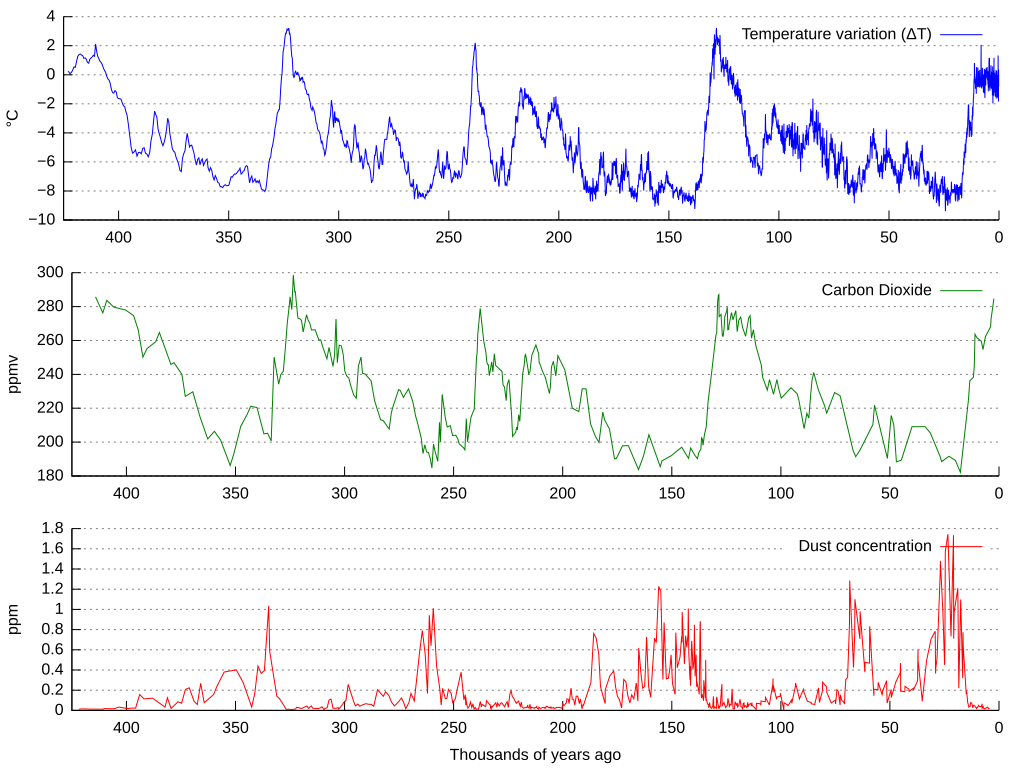
Caption: The last 450 kyr of the Quarternary glaciation (AKA the current ice age, 2.58 Myr--present) illustrated by runs of temperature anomaly (i.e., temperature relative to 15° C???) (blue curve), atmospheric CO_2 concentration (ppmv) (green), and dust concentration (red curve) determined from Vostock ice cores.
We will NOT discuss dust concentration in this figure.
Features:
- The
atmospheric CO_2 concentration (ppmv)
and dust concentration (?)
can be determined directly ??? from the
ice cores.
Temperature must be determined from
a climate proxy.
- The zero point for
temperature is NOT
zero Celsius.
What's plotted is
temperature anomaly (i.e., temperature relative
to 15° C???).
The zero point
is probably 15°C or close to that, but the original caption fails to specify it.
Note temperature given with zero point set to a fiducial value rather than the standard temperature scale zero is called temperature anomaly.
- The time periods of relatively low
temperature are roughly
the glacial periods of
the Quarternary glaciation.
During the glacial periods ice sheets covered extensive regions of the Northern Hemisphere, land and ocean.
The time periods of relatively high temperature are roughly the interglacials of the Quarternary glaciation.
Over the last 800 kyr, the glacial periods have been ∼ 100 kyr in length and the interglacials ∼ 10 kyr in length (see Wikipedia: Quarternary glaciation: Description).
- The Quarternary glaciation
started 2.580 Myr ago
(see Wikipedia: Quarternary glaciation)
and continues.
It is the defining feature of the
Quaternary geological period.
We are currently in an interglacial called Holocene (∼ 11,700 BP--present).
-
Note Before Present (BP) defines
1950 Jan01 as "Present", but "present" is, of course,
right now.
However, the current hypothesis for the next glacial period, put succinctly, is the Next Glacial Period (maybe 50,000---100,000 years AP = after present).
- The graph does NOT
show the very recent past from circa
1700 to present actual present
circa the 21st century.
The scale is too large to show the details of the post-1700 epoch where anthropogenic effects (mostly obviously anthropogenic CO_2 concentration increase and global warming) have become important.
- The
causes of Quarternary glaciation
have NOT been fully elucidated.
However, there is a complex interaction of effects from the biosphere, geology, atmospheric composition (in particular the varying atmospheric CO_2 concentration), and the astronomical Milankovich cycles.
The Milankovich cycles are as follows:
- axial precession with period ∼ 26 kyr.
- apsidal precession with period ∼ 112 kyr (see Wikipedia: Apsidal precession: Long-term climate.
- long-term axial tilt oscillation with period ∼ 41 kyr. For the next 1 Myr, the long-term axial tilt oscillation will cause the Earth's axial tilt to oscillate over the range 22°13'44"--24°20'50". So a variation of ∼ 2°. At present, the axial tilt = 23.44° and is decreasing.
None of the Milankovich cycles has constant rate of evolution due to astronomical perturbations (in particular gravitational perturbations).
Thus, they have NO exact periods.
The complex interaction of the Milankovich cycles among themselves and with the other causes of Quarternary glaciation results in the inexact periodicity of the glacial period-interglacials cycle of the Quarternary glaciation (2.580 Myr BP--present).
- There are 5
identified major ice ages
in Earth's geological history.
The causes of the ice ages
have probably NOT always been the same.
Image link: Wikimedia Commons: File:Vostok Petit data.svg.
Local file: local link: quarternary_glacial.html.
File: Earth geology file: quarternary_glacial.html.